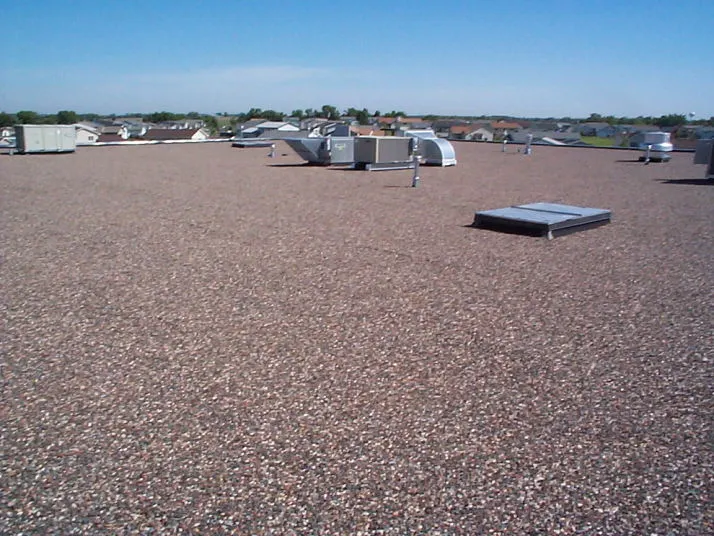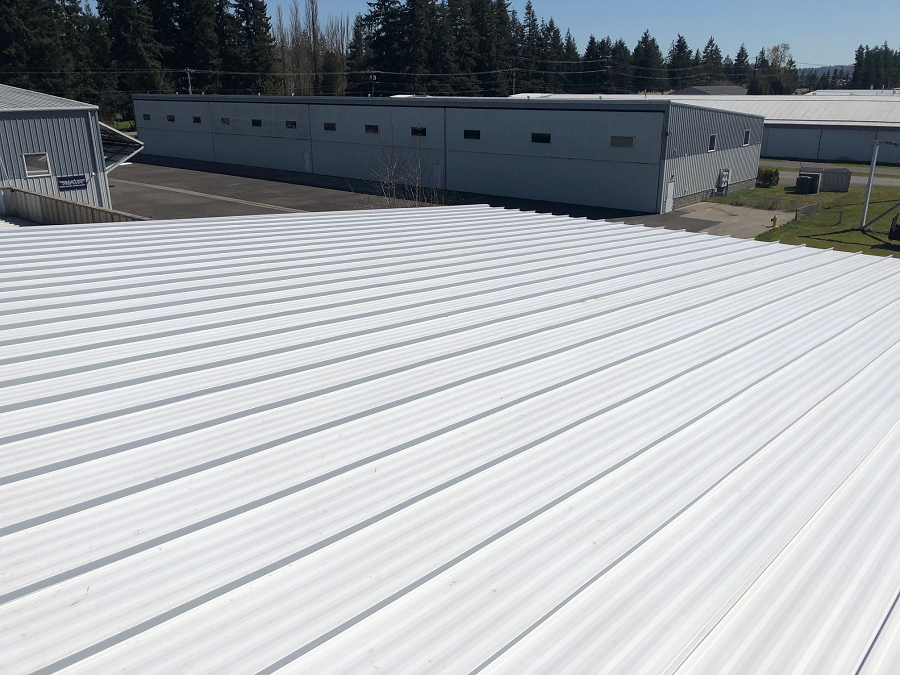The flexibility of a flat roof offers certain benefits, but flat roofs have a bit of a reputation for leaks and repairs. The good news is that there are material options for your flat roof beyond traditional hot-mopped, built-up roofing that will increase the reliability and longevity of the flat roof.
Flat roofs are not flat but have a very slight roof pitch of between 1/4 inch to 1/2 inch per foot: just enough slope to drain water but also flat enough to be a problem if not constructed properly.

Membrane roofing represents a modern advancement in roofing technology and has become the preferred option for commercial construction. Technically referred to as elastomeric or plastomeric roof membrane, based on the material composition, single-ply roofing is available in several varieties:

Of all these membrane types, EPDM synthetic rubber is one of the most typical single-ply membrane roof materials for both residential and commercial use. TPO roofs are also popular polymer-based, single-ply roof options consisting of three layers: a TPO polymer base, a polyester-reinforced scrim, and a TPO compounded top ply.
Roofing professionals install these roofs as thin sheet materials 0.030 (30 mils) to 0.060 inches (60 mils) thick and are applied to the roof in a single layer. Made of synthetic rubber or polymer, they are flexible and elastic and can handle temperature changes and some impact types better than built-up roofs.1
Membrane roofs are attached in a variety of ways. They can be partially loosely laid and held down with river rock ballast (requires roof structure to support the weight) or fully adhered to the roof deck. EPDM and neoprene roof seams are fastened by adhesive, PVC roof seams are heat or solvent-welded, and TPO roofs can be installed using a combination of methods, including mechanical fasteners, adhesives, and heat welding.
Modified bitumen (asphalt) cap sheet roofing was developed in the 1960s as a replacement technology for BUR, or built-up roofing, by using the proven technology of BUR and adding polymer-reinforced roof wear layers or cap sheets.
These roofs can be installed using techniques determined by the project's specific requirements and material specified. These installation methods include:
The polymer used in the cap sheet provides improved elasticity and flexibility in lower temperatures. The most commonly used polymers are atactic polypropylene (APP) and styrene butadiene styrene (SBS). SBS imparts a rubber-like characteristic to the bitumen.
SBS cap sheets are usually installed using cold adhesives or hot asphalt tar. On the other hand, Thermoplastic APP sheets are installed utilizing the torch-applied method.


The built-up roof, or BUR, is often considered the progenitor of flat roofing. For generations, built-up roofs have effectively addressed the issues associated with low-pitched roofs, a task that asphalt shingles have consistently failed to manage.
Built-up roofs are installed using several layers of a particular type of roofing felt that has been asphalt-impregnated and embedded in bitumen with a hot mop.
The hot-applied asphalt or coal tar pitch blends with the bitumen-soaked roof felt, creating a monolithic roof membrane. The roof felt/asphalt tar layering is repeated in overlapping layers until the assembly is two to four thick plies.
A wear surface of finely crushed stone granules is usually applied to the top layer of hot tar to protect the built-up roof assembly from UV light and weather.


Metal roofs are super durable and tend to be more expensive, but they are an excellent choice for longevity. They can last from 30 to 50 years.
Standing seam metal roofs have long metal panels joined at the seams with concealed fasteners. These panels are not bolted onto the roof. Instead, they can contract and expand with climate conditions. The most common metals used are steel, stainless steel, copper, and aluminum.
Metal roofs are not the best option for roofs that have zero pitch. If any pooling occurs, they can form leaks between the seams. But due to their durability and recyclability, they are one of the more sustainable choices.







The best materials for a flat roof depend on your needs. For instance, modified bitumen is your best bet to save money. It has surpassed built-up roofs in popularity because they're easier and quicker to install. However, it only lasts about 15 to 20 years, half as long as single-membrane and metal roofs.
Built-up roofs are made of asphalt, boards, roofing felt, and gravel and are sealed with asphalt. This method is considered the old way of doing roofs. This method works well, but it has several downfalls, particularly the increased labor to install the several layers, the need to work with hot tar, and the materials from all the layers that add to the roof's overall weight.
Synthetic rubber, or EPDM, usually has a black surface, although you may be able to source a white top. Black EPDM absorbs light and heats rooms underneath. Black EPDM is favored in snowy regions since black rubber tends to melt snow faster. Rubber makes more sense for commercial properties and has excellent longevity, lasting up to 30 to 50 years.
Consider a PVC or TPO single-membrane roofing material if you prefer white roofing. It reflects light, keeping the space underneath cooler. These roofs are considered "cool roofs," reducing cooling costs, cutting energy usage, and lowering greenhouse gas emissions.2 This option is great for hotter climates. Single membrane roofs are easy to install by rolling out large rolls of the lightweight membrane. However, they can show dirt quicker than other options. The benefit of TPO over PVC is it has a higher puncture resistance3 and is not as slippery when wet.
Standing seam metal roofs will likely be the best option for lasting the longest; however, the aesthetics of a metal slatted roof may not be for everyone. This option is the most expensive, but it also tends to last the longest, and environmentally, it is one of the most eco-friendly choices as it's 100% recyclable.
The cost to replace a flat roof averages about $10,000, ranging between $4,000 and $19,000.5 The difference in price accounts for the type of roofing material you want, the size of your roof, and regional variances in cost. Generally, a new flat roof will cost about $4 to $14 per square foot for materials and labor.
The least expensive material is modified bitumen. Single-layer membrane roofing, like rubber and TPO, is in the middle range, while metal tops the high end. Modified bitumen has a shorter lifespan, lasting about 15 years. TPO and PVC can last 30 to 40 years, while metal roofs can last 30 to 50 years.
Single-layer membrane and standing seam metal are the best roofs for their longevity and water-tightness.
Rubber (EPDM) or metal roofs are preferred for longevity, with lifespans between 30 to 50 years.
Determining which is better between EPDM and TPO depends on your climate. EPDM, usually made of black rubber, is recommended for colder, wintry climates with its insulating properties, and TPO, with its white, reflective surface, is best for hotter, sunnier climates.
Modified bitumen is the least expensive method for installing a flat roof.
The average lifespan of a flat roof is about 20 years; however, certain materials, such as rubber and metal, have much longer lifespans. Modified bitumen tends to last less, about 15 years.